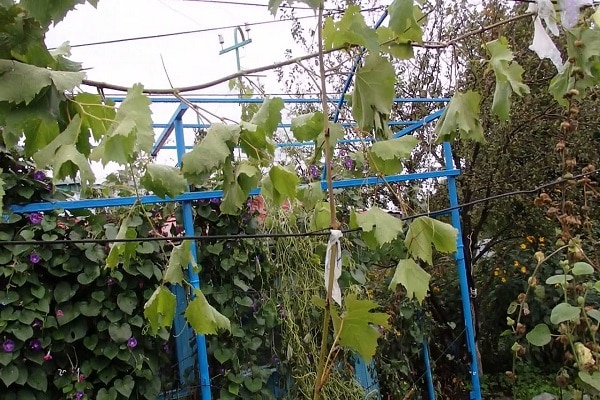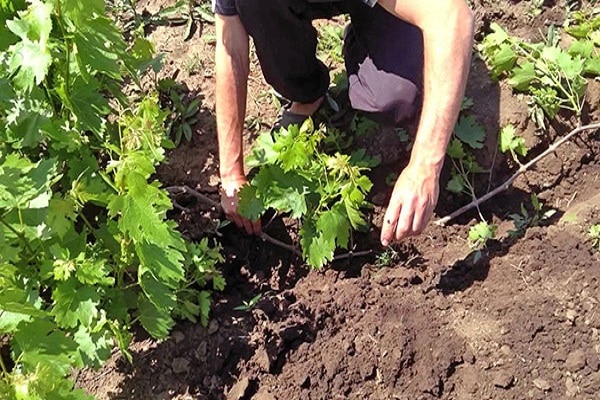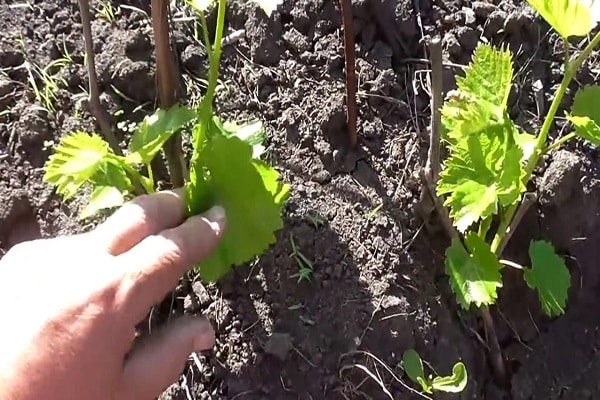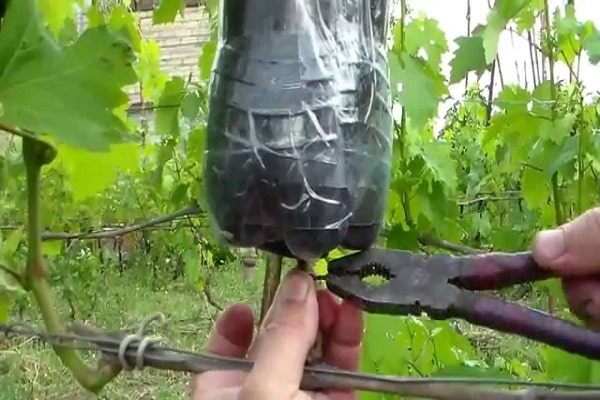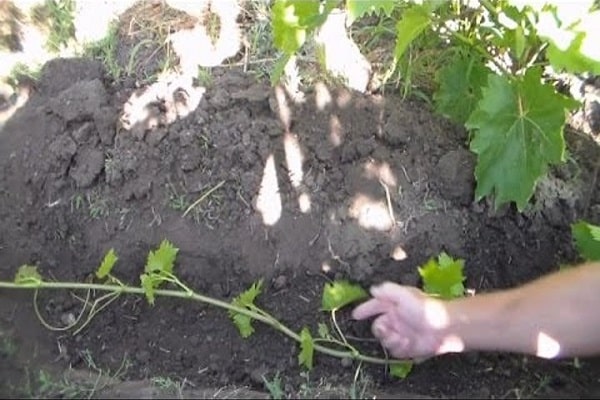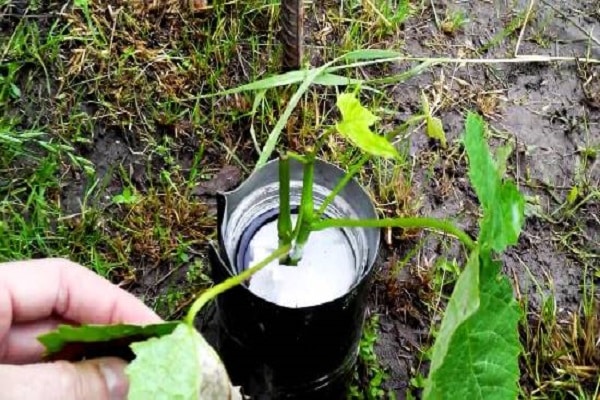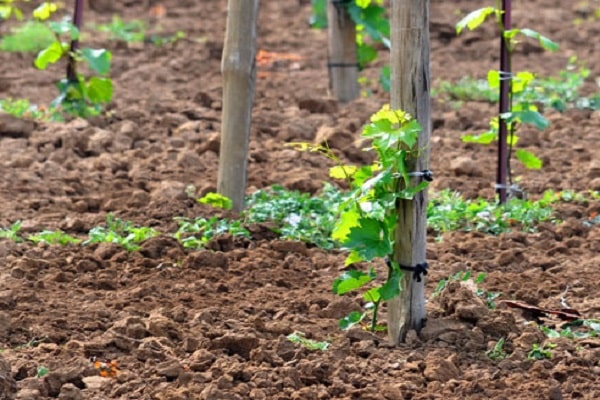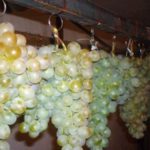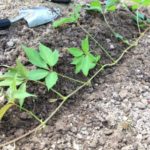Propagation of varietal grapes by layering is becoming increasingly popular among summer residents who want to increase the number of bushes on their plot without spending a lot of money. The technique has several effective ways to not only increase the number of plants on the site, but also insure or replace old and weak bushes.
What is grape layering?
Even difficult-to-root grape varieties can be propagated quite easily by layering.Other methods for them do not bring the desired result. It must be remembered that the method is good only in those areas where root diseases have not previously occurred.
Professional winegrowers call layering twigs buried in the ground and rooted, which, after being separated from the mother bush, can be used as independent seedlings and the plant can be propagated with them. Thanks to the direct connection of the cuttings with the mother plant, the necessary nutrition is provided, the seedling develops well and actively develops its own root system.
Many adventitious roots are formed, ensuring good and rapid survival of the young bush.
Pros and cons of the layering method
Propagation of grapes by layering has its strengths and weaknesses, taking into account which the gardener decides whether to use this technique on his site. The advantages include:
- can be used to restore and propagate old bushes;
- obtaining planting material for further planting;
- increasing the area of your own vineyards and making a profit from the sale of planting material;
- the use of seedlings in landscape design by creating bushes with unusual shapes;
- preservation of varietal characteristics of the mother plant;
- excellent survival rate;
- the opportunity to get a harvest in the first year after planting.
The disadvantage is that when a grape bush is propagated by layering, the mother plant is greatly depleted.
What are the methods for layering grapes?
Methods for layering grapevines are classified depending on the method used for digging. When propagated by green layering, the branches take root well, and the young plant takes root easily and quickly.For this procedure, you will need to select the strongest plant of the desired variety, characterized by good yield. It is better if it grows in a spacious place. Preparatory work is carried out in the spring, when the grape bush is pruned.
When pruning, select a pair of lower shoots, which will subsequently be laid in the ground. It will be wonderful, the branches are located close to the ground. In the summer, when their length reaches a couple of meters, a trench half a meter deep is dug near the grapes. The walls and bottom are made vertical. Organic fertilizers are mixed with soil and poured into the bottom of the trench.
All leaves and shoots are carefully trimmed from the selected shoots, after which they are placed in a prepared hole and half covered with earth.
Next, you need to water the ditch generously and fill the soil to the top. The top of the vine is pulled out and attached to a wooden support. Throughout the summer period, the layering is periodically moistened and loosened, while simultaneously removing emerging weeds. By the end of summer, the top of the grapes is broken off, thereby limiting the growth of the above-ground part and allowing the plant to devote all its energy to the formation of adventitious roots.
If the cuttings obtained in this way are planned to be stored for the winter, then it must be well insulated. By the end of September, the young grape bush can already be separated from the mother plant and placed for storage in a closed room (for example, in a basement). This procedure can be carried out in the spring, before planting in a permanent place of growth.
There is another time-tested method of propagating grapes - air layering. Despite the fact that it was invented quite a long time ago, its popularity has not diminished.Its essence is to ensure that a new root system is formed on the woody shoot. For this purpose, in the spring, when pruning, select the strongest shoot and tear off all the leaves from it. 20 cm are removed from the top of the branch, an incision is made in the bark in a circle, the width of which is up to 5 mm.
This place is wrapped in damp moss, and the top is wrapped in black cellophane. After a certain time, roots should form in this place. In the fall, the shoot with roots is separated from the mother plant and planted in flower pots or plastic cups, and then sent to a cool place until spring. With the onset of warmth, young grape bushes are planted in a permanent place of growth.
Propagation of grapes by layering according to the season
Grapes are propagated in summer when the length of the vine has already reached 2-2.5 meters. Typically this period occurs at the end of July or the first half of August. Select several of the strongest branches located closest to the soil and completely tear off the leaves from them. After this, the grapevine is placed in a groove prepared in advance, bringing a pair of eyes to the surface.
In autumn, grapes are propagated extremely rarely, but if the need arises, the procedure can be carried out using any method of rooting the cuttings.
A feature of autumn propagation is that it is advisable to dig up the resulting young plant before frost, plant it in a pot and store it in the basement. If this is not possible, then you can leave it to winter in the garden bed, while providing good shelter. Covering material is laid with a thickness of at least 20 cm.
In the spring, to propagate grapes, they most often resort to hilling the head of the bush. Its disadvantage is that the mother plant is depleted.Suitable for those varieties that are characterized by compact size and low bush formation. With the onset of warmth, all the branches on the grapes are pruned in such a way that there is a gap of a couple of eyes.
When they grow 25 cm, they are covered with a layer of soil and watered. During the season, make sure that the soil is constantly moist, otherwise roots will not form. With the onset of autumn, the cuttings are cut as close to the soil level as possible.
Tips for transplanting and caring for layerings
Proper care of grape bushes obtained as a result of rooting cuttings will help not only increase their viability, but also speed up the first harvest. The soil must be loosened in a timely manner and very carefully, and emerging weeds must be removed. Regular watering is of great importance, which is done no more than once every 10 days. Irrigate the soil in special grooves or directly into the holes of the plant. The soil should be loosened as the upper layers become compacted due to precipitation or watering.
The grapes respond gratefully to timely application of fertilizing. Potassium and phosphorus fertilizers are of great importance for it.
The formation and development of future fruit buds, as well as the level of sugar content in ripened fruits, depend on the presence and reserves of phosphorus. Potassium increases the protective properties of the plant and stimulates growth processes. Nitrogen also has a positive effect on development and growth, but it is important not to overdo it with this trace element. Otherwise, the grapes will begin a protracted growth process, and they will not have time to prepare for winter. As a result, frost resistance decreases and there is a risk of freezing of the young plant.
In order for the young vine to acquire a vertical position, it is recommended to tie it to pegs installed in advance. In the first year of life, only 3 shoots are left on the grapes. If more of them appear, then the strongest ones are selected, and the rest are carefully pruned.
Before the onset of cold weather, the branches are cut so that their length is up to 1 meter and bent to the ground. A layer of soil taken from the middle of the rows is poured on top of the young grapes. This procedure is carried out after the first frost has passed. In winter, snow retention should be organized in the vineyard.
General tips and tricks from gardeners
Grapes can be propagated by layering in different climatic conditions. For planting, it is better to choose a well-lit, sunny place, protected from drafts. The soil on the site is selected to be fertile, because when new grape bushes appear, the consumption of microelements and nutrients from it increases.
To measure the length of a young vine, they resort to using a centimeter tape, which is popularly called a centimeter. Garter of grape branches made using twine, rope or thin pieces of fabric. When transplanting young bushes, fuss and haste should be avoided, because this often leads to damage to the shoots and a weak root system. This mistake is often made not only by beginners, but also by experienced winegrowers.


